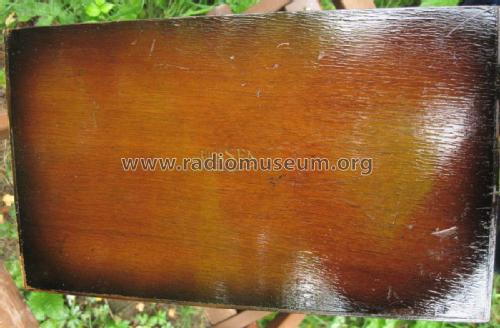Two Valve Portable Battery
Lissen Ltd.; London and Richmond, Surrey
- Country
- Great Britain (UK)
- Manufacturer / Brand
- Lissen Ltd.; London and Richmond, Surrey
- Year
- 1932
- Category
- Broadcast Receiver - or past WW2 Tuner
- Radiomuseum.org ID
- 282858
Click on the schematic thumbnail to request the schematic as a free document.
- Number of Tubes
- 2
- Main principle
- TRF (Tuned-Radio-Frequency but use of regeneration unknown); 1 AF stage(s)
- Wave bands
- Broadcast (MW) and Long Wave.
- Power type and voltage
- Storage and/or dry batteries
- Loudspeaker
- Magnetic loudspeaker (reed) generic. / Ø 11 inch = 27.9 cm
- Material
- Wooden case
- from Radiomuseum.org
- Model: Two Valve Portable [Battery] - Lissen Ltd.; London and
- Dimensions (WHD)
- 362 x 336 x 190 mm / 14.3 x 13.2 x 7.5 inch
- Notes
-
Clip in Metal rear panel.
Price approximate, one ot the cheaper models at Manchester Radio Show, 28th September 1932
Mullard lists PM1A and PM22A for the Lissen "Transportable 2", which is either the same model or an almost identical model.. The HL2 and PT225 are typical Lissen rebadging of these (see similar era Lissen Skyscraper kits)
See forum notes and the AC mains version
- Price in first year of sale
- 3.75 GBP
- Mentioned in
- -- Original prospect or advert (Page 319 September 30th 1932 Wireless World)
- Author
- Model page created by Michael Watterson. See "Data change" for further contributors.
- Other Models
-
Here you find 159 models, 124 with images and 58 with schematics for wireless sets etc. In French: TSF for Télégraphie sans fil.
All listed radios etc. from Lissen Ltd.; London and Richmond, Surrey
Collections
The model Two Valve Portable is part of the collections of the following members.
Forum contributions about this model: Lissen Ltd.; London: Two Valve Portable
Threads: 1 | Posts: 3
or Informed speculation?
This was one of the cheapest models on 28th September 1932 at the Manchester Radio Show. It would be reasonable to assume it's basically a battery version of the 2 valve mains model featured in November 1932 Wireless World.
That would mean it would have used an HL2 or similar for detector and PT225 or similar for speaker driver, probably Mullard made with Lissen bases. There would have been three HT taps to save resistors and capacitors, the primary of transformer on HL2 anode, the screen of PT225 and the supply to speaker motor.
The top knob is likely the tuning with a 0 to 100 scale, middle wire to short LW coil for MW operation, lower knob the reaction. The 2V LT switch probably in the lower slot. The 120V tapped HT pack and 9V tapped GB pack would not have been switched, to save money. Likely one grid leak resistor on HL2 and just two fixed capacitors, RF coupling to grid and RF decoupling on HL2 anode. Transformer (1:2 or maybe as high as 1:5) to couple the valves.
The aerial and earth wires via a cut out corner on back plate. The blocks to position the 2V Lead acid cell and standard tapped 120V dry cell battery pack can be seen on the base of the case. I assume the tapped 9V grid bias pack clipped to the chassis, held by four screws to side of case with the control panel cut-out. There are no other mounting holes.
Michael Watterson, 16.Jun.16





